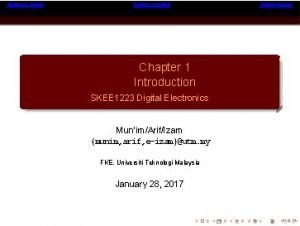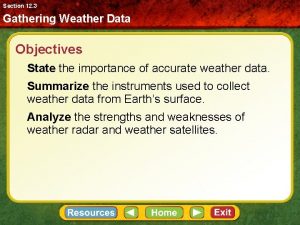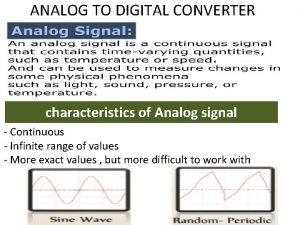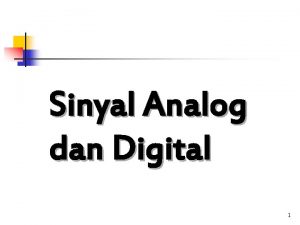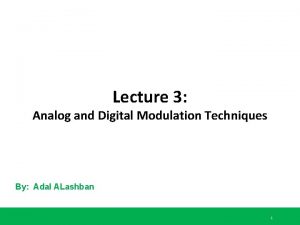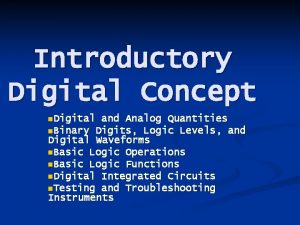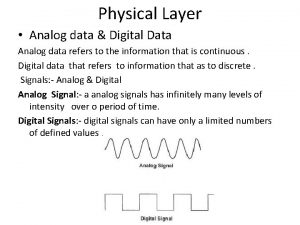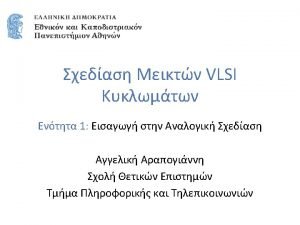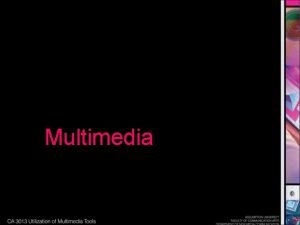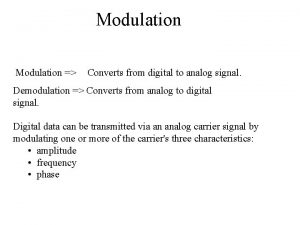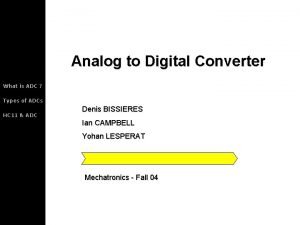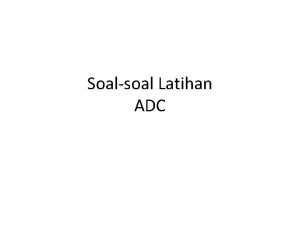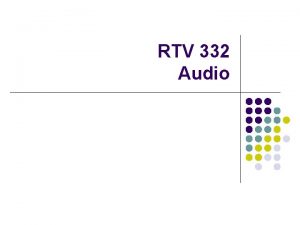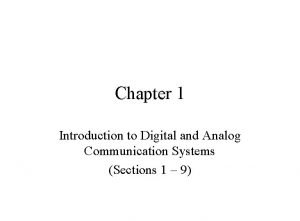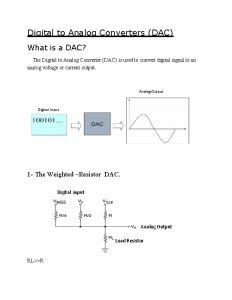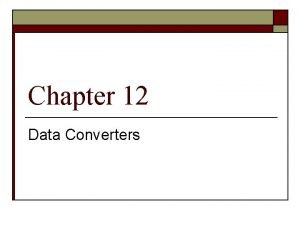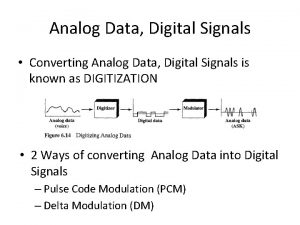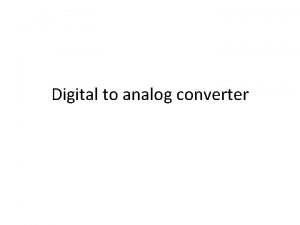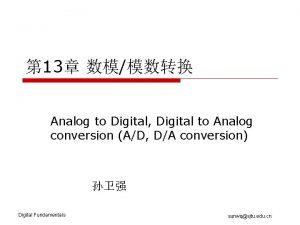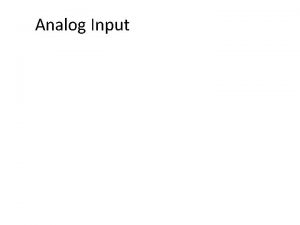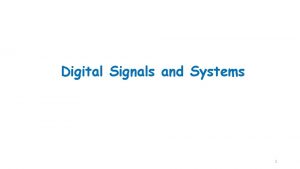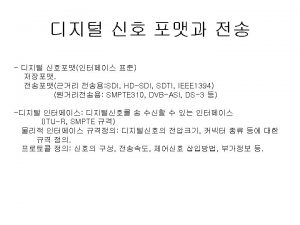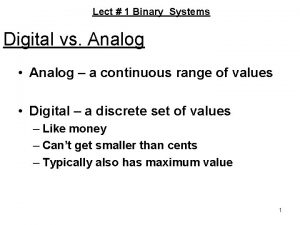Signals 1 Signals Introduction n Analog and Digital




































- Slides: 36

Signals 1

Signals Introduction n Analog and Digital n 2

Introduction n Information can be in the form of data, voice, picture, etc. Internally (in a computer) it is represented in the form of a stream of 1 s and 0 s When it is transmitted across network links, it is converted into a form that transmission media can accept – Electromagnetic signals 3

Analog and Digital n n Data and Signals can be represented in analog or digital form Analog – Refers to something that is continuous – A set of specific points of data and all possible points between n Digital – Refers to something that is discrete – A set of specific points of data with no other points between 4

Analog and Digital n Analog and Digital Data : examples – Analog data n Human voice n A continuous wave is created n Converted to analog signal – Digital data n 0/1 data stored in a computer n converted into digital signal 5

Analog and Digital n n Analog and Digital Signals Analog signal – A continuous wave form – There are infinite values along a path 6

Analog and Digital n Digital signal – Discrete – It has a limited number of defined values (0/1) 7

Analog and Digital Signals 8

Periodic Signals A periodic signal consists of a continuous repeated pattern n The period of a signal (T) is expressed in seconds n 9

Periodic Signals 10

Aperiodic Signals Signal has no repetitive pattern 11

Analog Signals Simple analog signal : a sign wave form 12

Analog Signals : Sign Wave n 3 characteristics of a sign wave – Amplitude n The height of the signal n The unit : volt, ampere, watt – Period and frequency n The amount of time (in seconds) a signal needs to complete one cycle n Frequency = the number of periods in one second (number of cycles per second( 13

Amplitude at time t 1 Maximum Amplitude t 1 Minimum Amplitude 14

Frequency is a rate of change with respect to time n Change in a short span of time means high frequency n Change in a long span of time means low frequency n If a signal does not change at all, its frequency is zero n 15

Period and Frequency 3 periods in one second Frequency = 3 Hz One second Period = 1/3 second 16

Phase Describes the position of the waveform relative to time zero n Phase is measured in degrees or radius (360 degrees is 2 Pi radians) n 17

Phases 18

Amplitude Change 19

Frequency Change 20

Phase Change 21

Time and Frequency Domains 1 second 12 Frequency = 7 Hz 12 7 22

Time and Frequency Domains n A low frequency signal in the frequency domains corresponds to a signal with a long period in the time domain and vice versa n A signal that changes rapidly in the time domain corresponds to high frequency in the frequency domain 23

Examples 24

Signal with DC Component 25

Complex Waveform 26

Bandwidth 27

Digital Signal 28

Amplitude, Period, and Phase for a Digital Signal 29

Bit Rate and Bit Interval 30

Harmonics of a Digital Signal 31

Exact and Significant Spectrums 32

Bit Rates and Significant Spectrums 33

Bandwidth and Data Rate 34

Example 35

36
 Analogue and digital transmission in computer networks
Analogue and digital transmission in computer networks Analog vs digital chips
Analog vs digital chips Introduction to digital control system
Introduction to digital control system Introduction to digital control system
Introduction to digital control system Digital data digital signals
Digital data digital signals Digital data digital signals
Digital data digital signals Compare and contrast weather
Compare and contrast weather Compare and contrast analog and digital forecasting
Compare and contrast analog and digital forecasting Characteristics of analog signals
Characteristics of analog signals Periodic analog signals
Periodic analog signals Digital to analog modulation techniques
Digital to analog modulation techniques Introduction to digital video
Introduction to digital video Difference between analog and digital editing
Difference between analog and digital editing Analogue and digital transmission
Analogue and digital transmission Analog image and digital image
Analog image and digital image Digital and analog quantities
Digital and analog quantities Analog and digital video in multimedia
Analog and digital video in multimedia Analog data and digital data
Analog data and digital data Compare analog and digital filters
Compare analog and digital filters Razavi cmos analog circuit design
Razavi cmos analog circuit design Communicative signals and informative signals
Communicative signals and informative signals Communicative and informative signals
Communicative and informative signals Communicative and informative signals
Communicative and informative signals Pengertian teknologi digital dan analog
Pengertian teknologi digital dan analog Analog v digital
Analog v digital Modulation digital to analog
Modulation digital to analog Perbedaan analog dan digital
Perbedaan analog dan digital Types of analog to digital converters
Types of analog to digital converters Analog to digital converter
Analog to digital converter Pengertian adc
Pengertian adc Contoh soal analog to digital converter
Contoh soal analog to digital converter Rtv 332
Rtv 332 Digital signal as a composite analog signal
Digital signal as a composite analog signal Analog vs digital communication systems
Analog vs digital communication systems Kelemahan modulasi digital adalah
Kelemahan modulasi digital adalah Digital to analog converter
Digital to analog converter Digital to analog converters basic concepts
Digital to analog converters basic concepts

